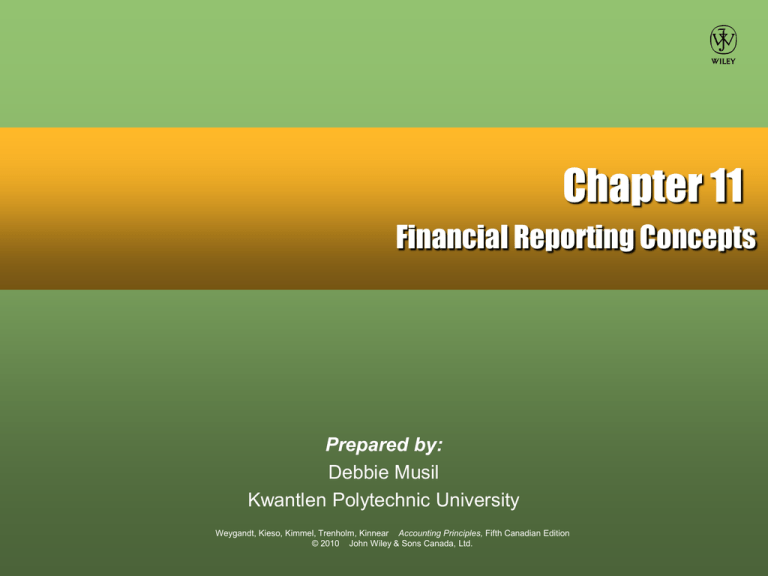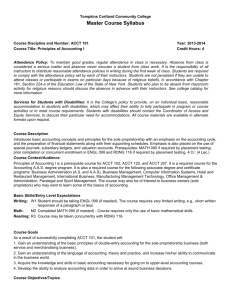
Chapter 11
Financial Reporting Concepts
Prepared by:
Debbie Musil
Kwantlen Polytechnic University
Weygandt, Kieso, Kimmel, Trenholm, Kinnear Accounting Principles, Fifth Canadian Edition
© 2010 John Wiley & Sons Canada, Ltd.
Financial Reporting Concepts
•
•
•
•
•
Conceptual Framework of Accounting
Objective of Financial Reporting and
Underlying Assumptions
Qualitative Characteristics of Accounting
Information
Constraints on Financial Reporting
Recognition and Measurement Criteria
Weygandt, Kieso, Kimmel, Trenholm, Kinnear Accounting Principles, Fifth Canadian Edition
© 2010 John Wiley & Sons Canada, Ltd.
Conceptual Framework of
Accounting
•
A foundation for accounting:
• Ensures existing standards and practices are
clear and consistent
• Makes it possible to respond quickly to new
issues
• Increases the usefulness of financial
information presented in financial reports
•
Standards built on general principles, not
rules
Weygandt, Kieso, Kimmel, Trenholm, Kinnear Accounting Principles, Fifth Canadian Edition
© 2010 John Wiley & Sons Canada, Ltd.
Conceptual Framework 2
•
Use professional judgement and framework to
determine appropriate accounting treatment
• Six major components to framework:
1. Objective of financial reporting
2. Underlying Assumptions
3. Elements of financial statements
4. Qualitative characteristics of accounting information
5. Constraints on financial reporting
6. Recognition and measurement criteria
Weygandt, Kieso, Kimmel, Trenholm, Kinnear Accounting Principles, Fifth Canadian Edition
© 2010 John Wiley & Sons Canada, Ltd.
Objective of Financial Reporting
•
To provide useful information for decision-making
• To give information about:
• Economic resources (assets) and claims on
those resources (liabilities, equity)
• Changes in resources and claims on them
• Economic performance
• Enables users to decide whether management
used company resources in the best way
possible
Weygandt, Kieso, Kimmel, Trenholm, Kinnear Accounting Principles, Fifth Canadian Edition
© 2010 John Wiley & Sons Canada, Ltd.
Underlying Assumptions
•
Accrual Accounting
• Assumed that all financial statements are
prepared using the accrual basis
• Due to its usefulness in decision-making
•
Going Concern
• Assumed that a company will continue
operating for the foreseeable future
• Important implications for how financial
information is presented
Weygandt, Kieso, Kimmel, Trenholm, Kinnear Accounting Principles, Fifth Canadian Edition
© 2010 John Wiley & Sons Canada, Ltd.
Elements of Financial Statements
•
Basic categories that are used in
accounting
• Assets, liabilities, equity, revenues, expenses,
and other comprehensive income
•
Must be precisely defined and applied
consistently
Weygandt, Kieso, Kimmel, Trenholm, Kinnear Accounting Principles, Fifth Canadian Edition
© 2010 John Wiley & Sons Canada, Ltd.
Qualitative Characteristics of
Accounting Information
•
To be useful, information should possess the
following qualitative characteristics (in order):
• Fundamental Qualitative Characteristics:
• Relevance
• Faithful Representation
• Enhancing Qualitative Characteristics:
•
•
•
•
Comparability
Verifiability
Timeliness
Understandability
Weygandt, Kieso, Kimmel, Trenholm, Kinnear Accounting Principles, Fifth Canadian Edition
© 2010 John Wiley & Sons Canada, Ltd.
Qualitative Characteristics:
Relevance
•
•
Accounting information is relevant if it
makes a difference in a decision
Relevant information has predictive and/or
confirmatory value:
• Predictive value: helps users forecast future
events
• Confirmatory value: confirms or corrects prior
expectations
Weygandt, Kieso, Kimmel, Trenholm, Kinnear Accounting Principles, Fifth Canadian Edition
© 2010 John Wiley & Sons Canada, Ltd.
Qualitative Characteristics:
Faithful Representation
•
•
Information must be a faithful representation
of the economic reality of reported events
This is achieved when the information is:
• Complete: includes all necessary information
• Neutral: information is free from bias
• Free from material error: will not affect
decisions by investors and creditors
Weygandt, Kieso, Kimmel, Trenholm, Kinnear Accounting Principles, Fifth Canadian Edition
© 2010 John Wiley & Sons Canada, Ltd.
Qualitative Characteristics:
Comparability
•
Comparability: Similar companies use the same
accounting principles
• Consistency: A company uses the same
accounting principles from year to year
• However, accounting principles can change:
• Due to new requirements that have been issued
• When management decides that a difference principle
gives more relevant & reliable information
•
Accounting changes are disclosed in the
financial statements
Weygandt, Kieso, Kimmel, Trenholm, Kinnear Accounting Principles, Fifth Canadian Edition
© 2010 John Wiley & Sons Canada, Ltd.
Qualitative Characteristics:
Verifiability and Timeliness
•
•
Verifiable: assures users that the accounting information
shows the economic reality of a transaction
• Information is verifiable if two knowledgeable and
independent people agree that it faithfully represents
the economic reality
Timely: accounting information is provided when it is still
useful for decision-making
• Available to decision makers before it loses its ability
to influence their decisions
Weygandt, Kieso, Kimmel, Trenholm, Kinnear Accounting Principles, Fifth Canadian Edition
© 2010 John Wiley & Sons Canada, Ltd.
Qualitative Characteristics:
Understandability
•
•
•
Information must be understandable to
users for it to be useful
Enables users to gain insight into a
company’s financial position and results of
operations
Users are assumed to have a reasonable
knowledge of:
• Business, economic and financial activities
• Financial reporting
Weygandt, Kieso, Kimmel, Trenholm, Kinnear Accounting Principles, Fifth Canadian Edition
© 2010 John Wiley & Sons Canada, Ltd.
Full Disclosure
•
•
Requires disclosure of circumstances and
events that make a difference to financial
statement users
Compliance is accomplished through:
• The data in the financial statements
• The notes that accompany the statements
•
A summary of significant accounting
policies is usually the first note to the
financial statements
Weygandt, Kieso, Kimmel, Trenholm, Kinnear Accounting Principles, Fifth Canadian Edition
© 2010 John Wiley & Sons Canada, Ltd.
Constraints on Financial Reporting
•
Allow GAAP to be modified without reducing the
usefulness of the reported information
• Cost-benefit constraint: the value of information
should be greater than the cost of providing it
• Materiality constraint: relates to an item’s impact
on a firm’s overall financial condition and
operations
• If an item will not make a difference in decision-making,
it is immaterial and GAAP does not have to be followed
Weygandt, Kieso, Kimmel, Trenholm, Kinnear Accounting Principles, Fifth Canadian Edition
© 2010 John Wiley & Sons Canada, Ltd.
Recognition & Measurement
Criteria
•
Recognition criteria help determine when items
should be included in financial statements
• Measurement criteria outline how to measure
these items
• An item is usually included if:
• It meets the definition of an asset, liability, equity,
revenue or expense
• It can be measured, and
• If a reasonable estimate of the amount can be made
•
Criteria is needed about when to record
revenues and expenses
Weygandt, Kieso, Kimmel, Trenholm, Kinnear Accounting Principles, Fifth Canadian Edition
© 2010 John Wiley & Sons Canada, Ltd.
Recognition & Measurement
Criteria
Two Important concepts underlying the
general criteria:
1. If an asset is going to be recorded it must
be probable there will be future economic
benefit
2. If a liability is going to be recorded it must
be probable there will economic
resources given up
Weygandt, Kieso, Kimmel, Trenholm, Kinnear Accounting Principles, Fifth Canadian Edition
© 2010 John Wiley & Sons Canada, Ltd.
Revenue Recognition Criteria
•
Revenue should be recognized at the
same time that:
• An increase in an asset is recognized, or
• A decrease in a liability is recognized
for profit-generating activities
Weygandt, Kieso, Kimmel, Trenholm, Kinnear Accounting Principles, Fifth Canadian Edition
© 2010 John Wiley & Sons Canada, Ltd.
Revenue Recognition:
Sale of Goods
•
Revenue recognized when all conditions met:
• Significant risks and rewards of ownership have
transferred from seller to buyer
• Seller no longer controls or manages goods
• Revenue can be reliably measured
• Probable increase in economic resources (cash
collected)
• Costs relating to sale can be reliably measured
•
For retail sales, these conditions are met at point
of sale
Weygandt, Kieso, Kimmel, Trenholm, Kinnear Accounting Principles, Fifth Canadian Edition
© 2010 John Wiley & Sons Canada, Ltd.
Revenue Recognition:
Service and Construction Contracts
•
Revenue is generally recognized when:
• Service is fully provided, and
• Probable that cash will be collected
•
•
Revenue may also be recognized as
chunks of services are provided
Recognition becomes more difficult if
earnings process lasts years
• Partial revenue recognition through the
percentage-of-completion method
Weygandt, Kieso, Kimmel, Trenholm, Kinnear Accounting Principles, Fifth Canadian Edition
© 2010 John Wiley & Sons Canada, Ltd.
Revenue Recognition:
During Production
•
•
Percentage-of-completion method recognizes revenue
based on reasonable estimates of progress to completion
Progress to completion is determining by comparing the
costs incurred to date to estimated total cost:
Costs Incurred
(Current Period)
Percent Complete
(Current Period)
÷
Total
Estimated Cost
×
Total
Revenue
=
Percent Complete
(Current Period)
=
Revenue
Recognized
(Current Period)
Weygandt, Kieso, Kimmel, Trenholm, Kinnear Accounting Principles, Fifth Canadian Edition
© 2010 John Wiley & Sons Canada, Ltd.
Revenue Recognition During Production:
Revision of Estimate
Costs Incurred
(To Date)
Percent Complete
(To Date)
Revised
Revenue
•
•
÷
Total
Estimated Cost
=
Percent Complete
(To Date)
×
Total
Revenue
=
Revised
Revenue
−
Revenue
Recognized
Previously
=
Revenue
Recognized
(Current Period)
When estimated project costs are revised, the percentage complete is also
revised by using costs incurred to date rather than per period
A revised revenue to date is then calculated and previously recognized
revenue subtracted to determine the revenue for the current period
Weygandt, Kieso, Kimmel, Trenholm, Kinnear Accounting Principles, Fifth Canadian Edition
© 2010 John Wiley & Sons Canada, Ltd.
Revenue Recognition:
Zero Profit Method
•
Revenue recognized is recognized to the
extent of costs incurred: no gross profit is
recognized until reliable estimates can be
made or contract is complete
•
Used by public companies when costs
cannot be estimated reliably
Weygandt, Kieso, Kimmel, Trenholm, Kinnear Accounting Principles, Fifth Canadian Edition
© 2010 John Wiley & Sons Canada, Ltd.
Revenue Recognition:
Completion of Production
•
Revenue, expenses and gross profit not
recognized until completion of project
• Used when costs cannot be reliably measured
•
Available for private companies not
reporting under IFRS
Weygandt, Kieso, Kimmel, Trenholm, Kinnear Accounting Principles, Fifth Canadian Edition
© 2010 John Wiley & Sons Canada, Ltd.
Expense Recognition Criteria
•
Expenses are recognized when there is:
• A decrease in an asset; or
• An increase in a liability
•
Not necessarily when the cash is paid
• Can be a direct association between costs
incurred and revenue earned
• When no direct relationship, another systematic and
rational allocation policy may be used
Weygandt, Kieso, Kimmel, Trenholm, Kinnear Accounting Principles, Fifth Canadian Edition
© 2010 John Wiley & Sons Canada, Ltd.
Measurement of Elements
•
Acquired assets are recorded at cost
• Cost is used because it is:
• Relevant: represents the price paid, assets sacrificed or
the commitment made at the date of acquisition
• A Faithful Representation: objectively measurable,
factual and verifiable
•
For some assets, more relevant to use fair value
• Amount of cash expected to be collected on sale
•
Some other assets and liabilities use amortized
cost
Weygandt, Kieso, Kimmel, Trenholm, Kinnear Accounting Principles, Fifth Canadian Edition
© 2010 John Wiley & Sons Canada, Ltd.
COPYRIGHT
Copyright © 2010 John Wiley & Sons Canada, Ltd. All rights
reserved. Reproduction or translation of this work beyond that
permitted by Access Copyright (The Canadian Copyright
Licensing Agency) is unlawful. Requests for further information
should be addressed to the Permissions Department, John Wiley
& Sons Canada, Ltd. The purchaser may make back-up copies for
his or her own use only and not for distribution or resale. The
author and the publisher assume no responsibility for errors,
omissions, or damages caused by the use of these programs or
from the use of the information contained herein.
Weygandt, Kieso, Kimmel, Trenholm, Kinnear Accounting Principles, Fifth Canadian Edition
© 2010 John Wiley & Sons Canada, Ltd.


